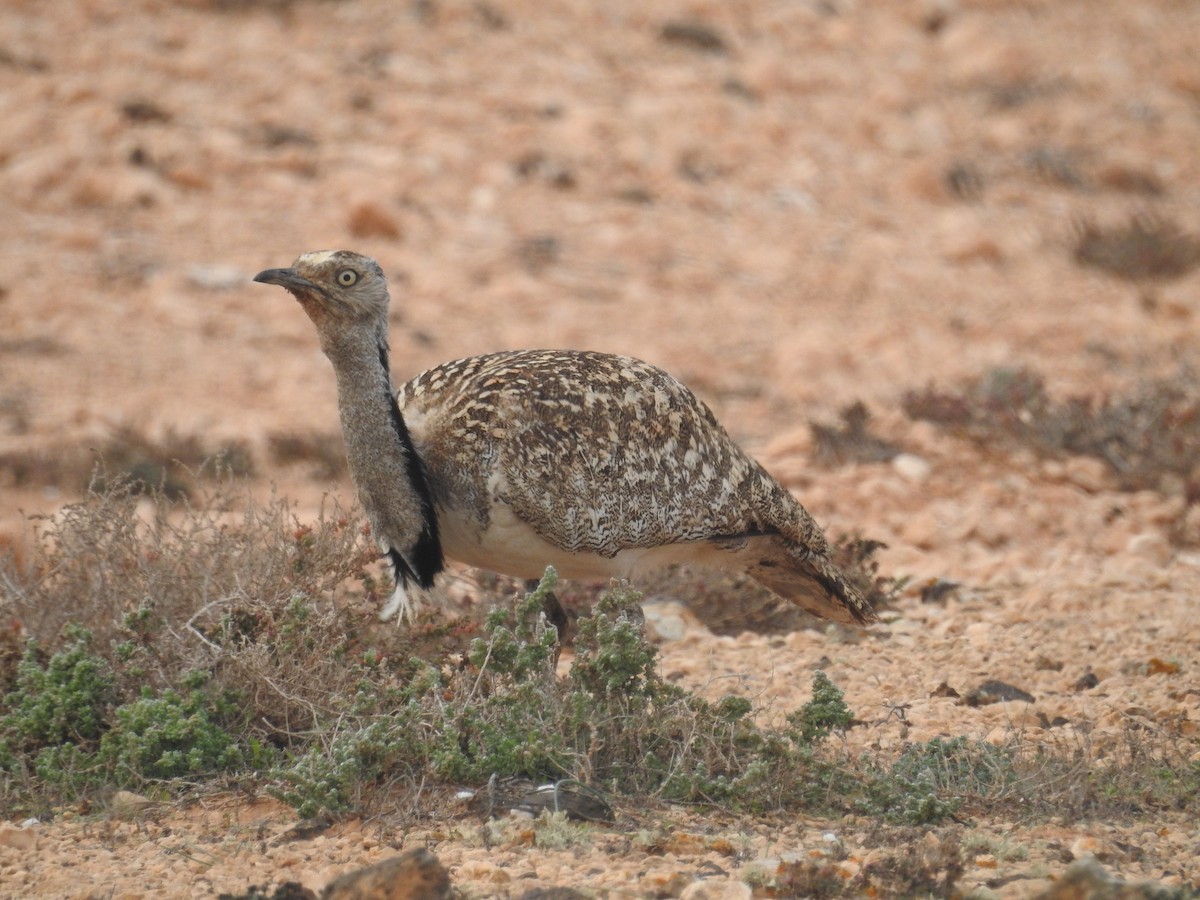Houbara Bustard
A species of Houbara Bustards Scientific name : Chlamydotis undulata Genus : Houbara Bustards
Houbara Bustard, A species of Houbara Bustards
Botanical name: Chlamydotis undulata
Genus: Houbara Bustards
Content
Description General Info
 Photo By Ashwin Viswanathan
Photo By Ashwin Viswanathan Description
The houbara bustard is a small to mid-sized bustard. It measures 55–65 cm (22–26 in) in length and spans 135–170 cm (53–67 in) across the wings. It is brown above and white below, with a black stripe down the sides of its neck. In flight, the long wings show large areas of black and brown on the flight feathers. It is slightly smaller and darker than MacQueen's bustard. The sexes are similar, but the female, at 66 cm (26 in) tall, is rather smaller and greyer above than the male, at 73 cm (29 in) tall. The body mass is 1.15–2.4 kg (2.5–5.3 lb) in males and 1–1.7 kg (2.2–3.7 lb) in females. 
Size
55 - 75 cm
Nest Placement
Ground
Feeding Habits
Houbara Bustard is omnivorous, consuming a diet of seeds, insects, and small animals. It forages on the ground, using unique adaptations to locate food, and has specific feeding times and preferences.
Habitat
The houbara Bustard thrives in arid and semi-arid landscapes, favoring environments like sandy semi-deserts with tussock grass, sparsely vegetated stony plains, and wormwood steppe. It typically occupies flat, open territories enabling good visibility and, seasonally, may frequent well-vegetated flats or cultivated fields. Habitats are selected based on visibility, foraging opportunities, and minimal human disturbance.
Dite type
Herbivorous
General Info
Feeding Habits
Bird food type
Distribution Area
The houbara bustard is found in North Africa west of the Nile, mainly in the western part of the Sahara desert region in Mauritania, Morocco, Algeria, Tunisia, Libya and Egypt. Some old records exist from Sudan as well. A small population is found in the Canary Islands. The Asian houbara or MacQueen's bustard which was earlier included in this species occurs east of the Sinai Peninsula. The North African species is sedentary unlike the migratory northern populations of MacQueen's bustards. The subspecies fuertaventurae of the Canary Islands is highly restricted and endangered. A 1997 survey found a total population of about 500 birds. 
Species Status
The International Fund for Houbara Conservation is the global leader in Houbara bustard conservation. A global conservation strategy was developed and implemented over the past forty years with the objective of ensuring the species has a sustainable future in the wild through effective and appropriate conservation programmes and management plans. Since 1995, the conservation strategy adopted consists of an integrated approach combining sound ecology, protection measures in the wild, conservation breeding, and effective reinforcement programmes. The IHFC was created in 2006 to further the original programme by managing international assets and securing partnerships across the range of the houbara, which encourage sustainable practices to ensure the species’ conservation. The Houbara conservation programme is supported by the government of Abu Dhabi. A multi-faceted Houbara conservation strategy has established breeding centers in the UAE (The National Avian Research Center and The Sheik Khalifa Houbara Breeding Center), Morocco (Emirates Center for Wildlife Propagation) and Kazakhstan (The Sheik Khalifa Houbara Breeding Center) to captive-breed Houbara and increase wild populations of the bird in its natural habitat across entire species range. In 2019, the International Fund for Houbara Conservation bred 484,351 Houbara and released more than 343,428 Houbara into the wild. The International Foundation for Conservation and Development of Wildlife (IFCDW) is a major conservation and breeding project established with funds from Prince Sultan Bin Abdul-Aziz Al Saud and based near Agadir, Morocco. The centre releases captive bred populations to boost wild populations. 

 Photo By Ashwin Viswanathan
Photo By Ashwin Viswanathan Scientific Classification
Phylum
Chordates Class
Birds Order
Bustards Family
Bustards Genus
Houbara Bustards Species
Houbara Bustard